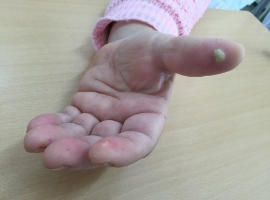Ana Oliveira Monteiro1*, Helena Barroca2 and M Teresa Cardoso3
1Department of Internal Medicine, Centro Hospitalar Universitario de Sao Joao, Porto, Portugal
2Department of Pathology, Centro Hospitalar Universitario de Sao Joao, Porto, Portugal
3Department of Internal Medicine, Centro Hospitalar Universitario de Sao Joao, Porto, Portugal
*Corresponding author: Ana Oliveira Monteiro, Department of Internal Medicine, Centro Hospitalar Universitario de Sao Joao, Porto, Portugal, Tel: +351225512200; E-mail: ana.galraoom@gmail.com
Received: January 13, 2021; Accepted: January 22, 2021; Published: February 24, 2021
Citation: Oliveira Monteiro A, Barroca H, Cardoso MT, et al. Atypical Location of Tophaceous Gout. Clin Image Case Rep J. 2021; 3(2): 142.


